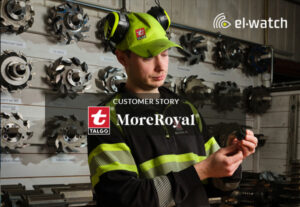Installing a small starter pack of wireless IoT sensors led to a production boost of nearly 50 percent at this Norwegian lumber company. Talgø MøreTre, a world-leading manufacturer of wood products with Royal weatherproofing, optimized its saw and planing mill, describing a completely new workday in production.


Photo: Talgø MøreTre/Nathan Lediard
The wood industry producer Talgø MøreTre in Surnadal has seen strong growth in recent years. With the rise in demand, time became even more valuable to the Nordmøre business, and production simply couldn’t keep up. The production facility consists of a sawmill, a planing mill, and the Royal weatherproofing vats, where the wood is refined to make the popular high-quality product MøreRoyal, which has taken a large share of the market.
Explore Talgø MøreTre here
Production Manager Paul Lilleløkken says the saws were far from being able to keep up with the capacity of the planer. Breakdowns were frequent and unpredictable, and Paul was preparing to invest in a new saw for NOK 4-5 million to ensure adequate production.
– “In addition to being a large investment in terms of money, these purchases require a lot of work, and we’d be spending a lot of resources on installation and commissioning,” says Paul, and continues:
– “We also faced major issues with large saw blades popping right off. We could see 5-6 of these every day, and at a cost of NOK 5000 – 10,000 per saw blade, this was obviously a challenge for us. We had to run the plant slowly to avoid breakdowns as best we could.”
Every operator we involved had differing opinions on what the causes could be, whether it was the feeding speed, thickness, or if something else was causing the breakdowns. It ran hot during breaks, and the company had no idea where to start.
Talgø also ran the powerful planer at the plant until it broke down too, as the spools and cutters welded themselves together. Paul estimates the total cost of such a breakdown to be about NOK 100,000. With 4-5 of these a year, this posed a major challenge to profitability.

The podcast from Woodworks Cluster focuses on how sensors solved production challenges with numerous breakdowns and downtime for Talgø MøreTre.
“We also faced major issues with large saw blades popping right off. We could see 5-6 of these every day, and at a cost of NOK 5000 – 10,000 per saw blade, this was obviously a challenge for us. We had to run the plant slowly to avoid breakdowns as best we could.”
Paul Lilleløkken, Production Manager Talgø MøreTre


The large saw blades was often popping right off at Talgø MøreTre before sensors were mounted and the problem was solved.
The solution
When Paul discovered El-Watch’s sensors, he was convinced that this equipment could be suitable for monitoring their production facility, which contains a lot of rotating equipment. After receiving further information from El-Watch, he was even more certain that this would be spot on for Talgø MøreTre, and he proposed the idea to Technical Manager Morten Aune. He was intrigued by the idea as well, and El-Watch quickly made suggestions for where and how sensors could be implemented at the plant. By 2019, the first sensors were in place at the facility. They were an immediate success, with results being seen already on the first day.
Product
Neuron Vibration Sensor
The Neuron Vibration measures vibration level and surface temperature every two minutes. The sensor has an embedded magnet at the back for easy installation.
Predictive maintenance
Morten Aune says that it has snowballed from there and that they are now installing sensors wherever they can.
– “For those of us who do maintenance, the sensors provide incredibly valuable information. If we want to know the state of a component, we set up sensors and monitor measurements over time and see how the figures develop. This allows us to optimize maintenance times and durations.”
At present, the lumber producer has sensors installed on planing spools, motors, and saw blades. They also have sensors installed on the heat exchangers in the Royal treatment process.


Wireless sensors mounted in production environment sends data that can be read on screens in the production halls, PC`s in the office or on tablets/smartphones anywhere.
A small investment, installed in 5 minutes
Talgø started small, with just a few sensors installed to a saw.
– “Early on, we installed 3 sensors to the resaw for just a few thousand NOK. Since then, we’ve fitted about 50 sensors at the plant, installed over a period of a few years.”
Morten installed all the sensors himself and says that this can be done quickly and with ease.
– “Yes, it’s really quick and easy. It takes me 5 minutes, then we get data and figures that can be read immediately”, he says.
See our selection of sensors here
Product
Neuron Ampere
The Ampere Sensor measures AC current and comes in several ranges from 10A to 500A RMS. The sensor comes with split core and is therefore easy to install onto existing power cables.
No breakdowns in 2 years
At first, the important thing is to learn from the sensor data in order to set experience-based alarm limits and to avoid having to rely on assumptions, which the company was previously forced to do. Maintenance staff can keep track of how the components are developing in the days and hours prior to a breakdown.
– “The sensors now warn us BEFORE a breakdown, so we can replace parts that are about to fail. We actually haven’t had a single breakdown since the sensors were installed 2 years ago. And just imagine how much we’re saving on being able to do maintenance on weekends and at scheduled times, instead of having an entire crew unable to work, watching us do maintenance”, says Morten.
Reduced costs – increased production volume
In addition to inspection and keeping track of maintenance needs, Talgø has reduced the costs of breakdowns by nearly one million NOK per year, in addition to being spared the NOK 4-5 million investment for a new saw. By monitoring the temperature of the saw, they got clear answers for how fast it could move – which was much faster than they had thought.
– “We can actually run it twice as fast as we dared to before we installed sensors. We’ve quite simply kicked it into the next gear, and it’s been a huge success. The sensors have led us to make some investments around the structure and the saw themselves. We’re now monitoring heat and power consumption, as well as vibration. We’ve got sensors on the saw pulley – and as long as the saw is stable and running at a good temperature, all is well. Now that the facility is as optimised as possible, we can use the equipment more efficiently, and we won’t be forced to invest in a new saw.”
It’s hard to say exactly how much we’ve saved, but it’s very clear that we’ve earned from being able to increase capacity at the facility by up to 50%. For us, the timing of this was incredible in a growing market for these wood products.



Photo: Talgø MøreTre/Jon Olav Ørsal
Sensors for the future
Ingar Fredriksen, the CEO of El-Watch, describes how sensors are poised to quickly gain influence in the industry over the coming years.
– “IoT (Internet of Things) and wireless sensors are a trend that will greatly benefit most manufacturing companies in the industry. This is exactly what the 4th industrial revolution is about: robots, predictive maintenance, and sensors. Wireless sensors from El-Watch are particularly suitable as they can handle tough conditions, high temperatures, dirt and debris, and have properties that are actually unique in the global market.”
The issues are the same everywhere – you want to get as much as possible out of your production and avoid undesired breakdowns, incidents, and major expenses.
Ingar Fredriksen, CEO El-Watch
The area of use at the wood industry company Talgø MøreTre can absolutely be transferred to most other industries, such as aquaculture, food goods, or processing industries, to name a few examples. Not to mention that the technology is just as suitable for small businesses as it is for large ones. The issues are the same everywhere – you want optimal production boost and avoid undesired breakdowns, incidents, and major expenses. Everyone has comparable components in their production, so this isn’t just a “wood industry phenomenon.”
Product
Neuron Infrared 380
The Neuron Infrared 380 sensor measures surface temperature on the object it is directed towards. It is designed for industrial temperature measurements, capable of measuring up to 380°C.
Read an article about how food producer and slaughterhouse Hovdenakk Hjort uses sensors here
The industry must innovate to increase productivity and efficiency, and there must be a will to change. Wireless sensors are very clearly a part of this, says Fredriksen, adding that Talgø MøreTre has been a model company in this respect.
– “Many companies are so busy fixing that malfunctioning motor that they don’t have the time to look at new solutions. Many also overestimate both the costs and how difficult it will be to get started. It’s easy to think that it’ll be a lot of work. It takes 5 minutes here! There’s no wiring, no need install outlets, and no reprogramming needed for systems, to mention a few benefits. You also get the overview on a web app, right there on the smart phone in your pocket.”
Ingar Fredriksen, CEO El-Watch
A changed workday
Paul Lilleløkken’s advice to companies that are considering getting into sensors is to hop in and start small. He also points out that without these optimization measures, the business would have needed to shift to a costly three-shift arrangement to meet demand. This would have driven up material prices.
– “The sensors have given us a completely new workday – we’re at a whole new level. Now we have actual data on the table. We can skip discussions and contradicting views based on opinion. Now we have actual knowledge.”
Paul Lilleløkken


Paul Lilleløkken showing the vibration sensor at the sawmill at Talgø MøreTre.
Morten Aune agrees, adding:
– “The workday has changed completely for us in maintenance. We don’t have to spend as much time on troubleshooting, or looking for issues that may not be there. The sensors provide clear notifications and provide us with the actual state of the component. Components that used to be swapped out frequently now have a longer lifespan, because we get concrete measurements for when they start to break down. Some products last longer than we thought, and others shorter.”
Morten Aune
The two Talgø men chuckle as they note that the discussions at lunch about where the problem is located are less intense now. Instead, they now have meaningful discussions about where they can place new sensors so the facility can be run even faster.





